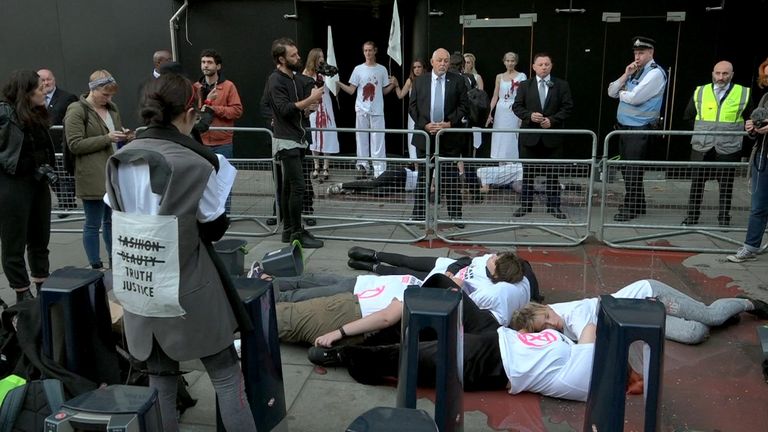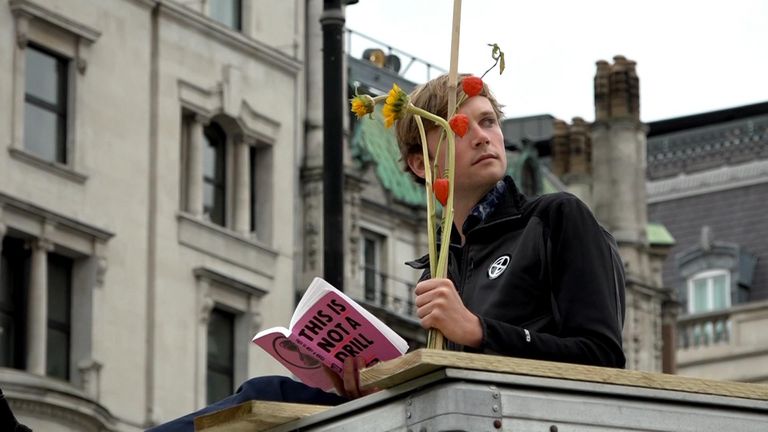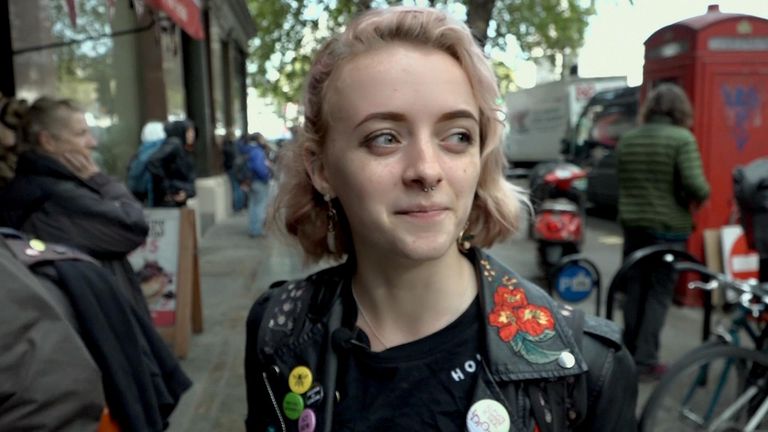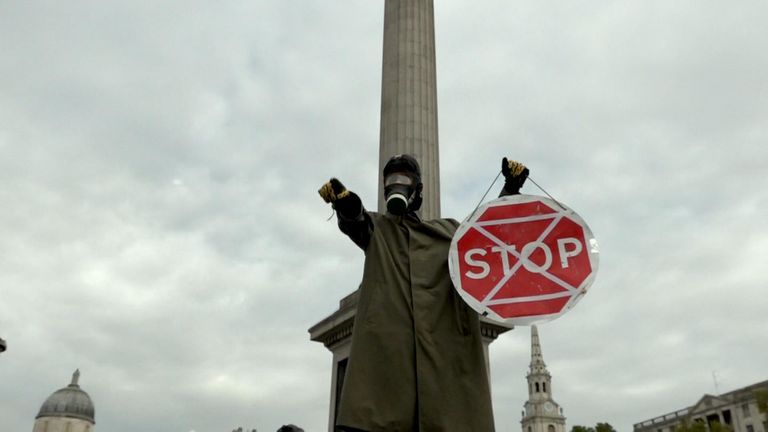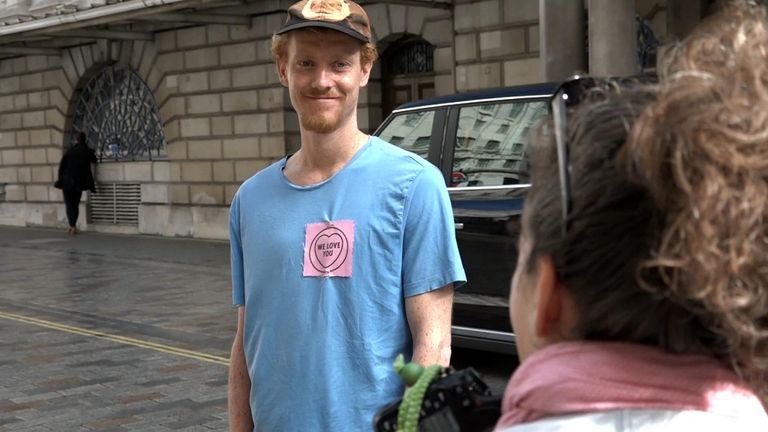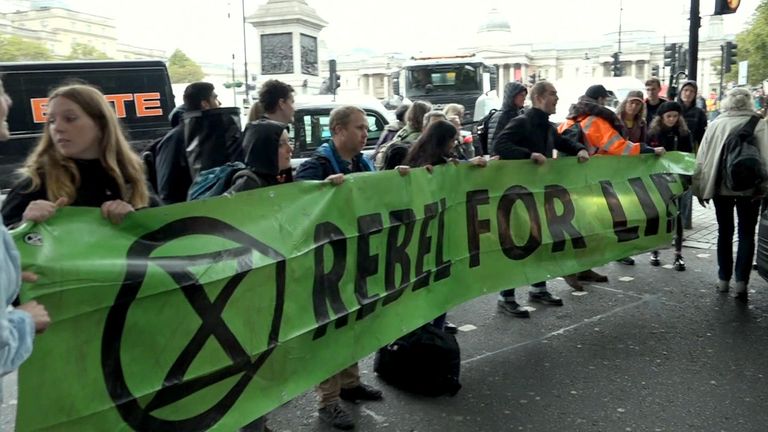Inside Extinction Rebellion: Two months embedded with climate change protesters
Their extreme form of activism has forced people to take notice – whether they like it or not.
I spent two months with Extinction Rebellion – also known as XR – as the movement attempted one of the biggest uprisings this country has seen in modern times.
The activists wanted to bring London to a standstill by disrupting millions of lives in order to get their message across.
That message is very powerful and very simple: If people do not change the way they live, then we and our planet will die.
I got to know the people behind XR, documenting their every move. I was with them as they planned and executed their ambitious and controversial plan to shut down the capital.
This is my story of being inside the rebellion.
Welcome to the rebellion
As soon as I set foot in their office, I realised they did things a little differently.
Some people walked around barefoot, there was a meditation room, everyone seemed to hug all the time, and they regularly broke out into dance sessions.
Apart from the two people who had invited me in, it was clear from the start that I was not very welcome.
I was met with resistance and hostility by some members of the ‘action team’. They are responsible for organising a lot of the illegal activity, like glueing themselves to government departments.
I later found out they thought I was an undercover police officer.
But over the next few weeks when they realised I wasn’t in that line of duty, their suspicions eased and I got to know them.
This unprecedented access allowed me to observe the inner-workings of an organisation that has changed the debate on climate change.
London Fashion Week: Fake blood and glue
About a month in, I was invited along to a protest, or “action” as they call them.
They told me to meet them at a location in central London at 4am and that they would be targeting London Fashion Week.
I was met by a dozen activists, mostly young women and teenagers. They changed into homemade white dresses and passed around small packages of what looked like red paint.
I asked what it was. “Fake blood, of course.”
Silly me. Of course it was.
Listening in to their preparations was surreal: “You’ll need to pour the blood on me. Both my hands will be glued on.”
They walked through the eerily quiet streets and stopped by a shop entrance. One of them squirted glue on their hands.
“It’s strong stuff – industrial glue,” one said. “Even if it doesn’t work, just pretend it’s glued on and they have to leave you.”
When they arrived, police and security guarded the entrance.
But then the activists struck. They pushed past barriers and sprinted towards the entrance and slapped their hands on the front door.
Mission accomplished. The entrance was blocked and the glamorous guests had to be ushered in through a side door.
The plan was to wait a few hours and get arrested. But they didn’t account for the cold weather. After a couple of hours, they decided to unglue themselves and leave.
Arrest classes: ‘Play dead’
Back at their office, the focus shifted to October.
One of the core aims of Extinction Rebellion is to drain the resources of the police in order to highlight climate change.
More than 1,000 people were arrested at their last mass ‘rebellion’ in April. They hoped for double this time around.
I was invited along to an XR training course where they prepared new members with how to behave when facing arrest.
It took place in the back of a pub and was run by a 19-year-old former drama student called Daisy Wyatt.
There were a dozen new members there, mainly aged between 30 and 50 – all keen and willing to be arrested in October.
Daisy warned them: “Being arrested is a very real possibility and a very scary prospect.”
That didn’t deter them. On to the role play scenarios. Daisy split the group into two groups: police and protesters. XR encourages people not to engage with police.
“You can do whatever you like but it’s best to play dead because it will take quite a few officers to take you into custody,” Daisy told them.
Nearly all who attended the course said they would be joining the uprising.
A mixed bag of protesters – and chaotic planning meetings
There were now just days until the October protests began. As the date drew closer, the tension grew higher.
Extinction Rebellion claims to be an entirely democratic organisation. That often means chaos.
One activist, Dr Bing Jones, a retired haematologist from Sheffield, put it well: “The idea is that people can do whatever they like as long as it’s within the principles of Extinction Rebellion, and self-organising systems are a key part of the whole thing.
“The downside is that it can be chaotic. It’s very much a mixed bag and it’s rather marvellous.”
A mixed bag it certainly was.
I spent a lot of time with the activists – pretty much every day for eight weeks. I have to admit, I became fond of a few of them.
There was Roman Paluch-Macknik, 26, a former office worker and one of the main organisers. He had a true rebel nature that I liked. He was willing to do whatever it took to stand up for what he believes in.
Then there was Daisy Wyatt, the teenage former drama student who had clearly been swept off her feet by Extinction Rebellion.
She, too, was willing to risk her future to shine a spotlight on a climate emergency.
I met some surprising characters during my time with XR. One was the charismatic Dr Bing Jones – he was fearless in his dedication to the cause.
There were several more like him. Passionate and intelligent, they were united by their passion for the cause.
Whatever you think of their methods, it’s hard not to admire their bravery and focus.
However, due to the leaderless structure, some may find dealing with XR infuriating.
I was invited to some of the Action Team’s planning meetings for the October Rebellion.
Even as an observer, I found them incredibly frustrating and sometimes unbearable. There were several meetings a day, each lasting two hours long. And, as far as I could see, nothing was ever achieved and they often ended up in childish spats.
Although, if you throw a dozen passionate people in the same room, it’s hardly surprising things get a little heated.
But there were brief moments when I thought they were incapable of shutting down anything, never mind the biggest city in Europe.
The rebellion begins
When the rebellion finally got under way, my doubts were proved wrong. A fire was lit and they sprang into action. Their time had come.
With military precision they shut down several sites across central London. The police were much more prepared this time, but still they couldn’t cope with the sheer volume of activists across several sites.
It was all coordinated by the Action Team who communicated with their “rebels” on the ground using disposable – or “burner” – phones.
I filmed as they took over the biggest site, Trafalgar Square. They had activists waiting by the six main road exits on the roundabout.
When the signal came, there was a coordinated ambush. Again, police didn’t stand a chance.
A few people were arrested, but the activists kept on flooding the streets. They had strength in numbers and were determined to stay.
But midway through day two, police decided enough was enough. The mood changed and the Met Police’s specialist public order officers moved in, making hundreds of arrests and destroying the mini campsites sprawled across central London.
In fact, a day later, I was nearly one of those arrested.
A close shave
It happened at London City Airport. I was filming a small group of XR members who were planning to block the private members’ entrance.
I was invited by organiser Roman Paluch-Machnik and met the group about a mile away from the airport. A white van was waiting for them. Inside that van was about 20 old bicycles. They were to be used as transport to the airport.
I followed the group as they rode to the target. But when they arrived, police were ready and waiting.
They had to think on the spot. “Here! Now!” Roman said.
Dismounting their bikes, the group reached for glue to attach themselves to the road. But police moved in. The activists barely got a chance to squirt it on their hands.
I sprinted and got as close as I could. I was filming the aftermath when an officer threatened to arrest me. I explained why I was there, showed him my press pass and left.
All of the XR members were arrested and taken into custody.
The rebellion ends
By the end of the two-week demonstration, nearly 2,000 activists had been arrested. Policing it cost more than £21m, Scotland Yard said.
About 30,000 people took to the streets to support Extinction Rebellion, and the movement doesn’t seem to be going away anytime soon.
But, for me, the lasting image of the October rebellion was when angry commuters turned on protesters attempting to stop a London Underground train.
In the final phase of the two-week protest, an activist was dragged down from the roof of a train at Canning Town.
Was this a shift in public mood? Was this a turning point?
I know for a fact that the attack sent shockwaves through the movement. I was told this by senior activists.
They told me it was a “humbling” experience and they know they need to work on engaging more with the public.
Extinction Rebellion does not exist to be liked. They’re there to deliver a message.
But it’s clear that those on the train platform that day were not willing – or able – to listen to that message.
Up until that point, Extinction Rebellion members I spoke to told me they didn’t care about disrupting people’s lives. It was necessary for the cause, they claimed.
They now have softened their tone.
The biggest question now is whether the rebellion will continue to rise, or will their provocative and divisive tactics become extinct?
Watch Inside The Rebellion – an intimate portrait of the climate protests that crippled London – on Sky News at 6:30pm and 8:30pm tonight
Source: Read Full Article




